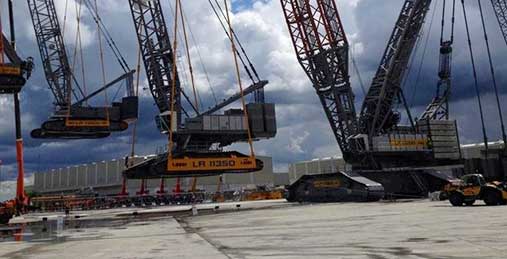ERIE, Pa. – The U.S. Department of Labor’s Occupational Safety and Health Administration and Turner Construction Company have established a strategic partnership to promote workplace safety for a building project at UPMC Hamot Medical Center in Erie, Pennsylvania. The partnership seeks to educate workers, control or eliminate serious hazards and establish effective safety and health programs for the project. The project – scheduled for completion in 2020 – includes a 200,000-square-foot, seven-floor patient care building. Through its Strategic Partnership Program, OSHA works with employers, employees, professional and trade associations, labor organizations and other interested stakeholders to establish specific goals, strategies … Read more
Brasfield & Gorrie Earns Safety Certification for Arizona Project
TUCSON, Ariz. – Brasfield & Gorrie recently attained Voluntary Protection Program Star certification at a Tucson, Arizona site where the general contractor is expanding Raytheon Missile Systems’ corporate headquarters. VPP is an Occupational Safety & Health Administration cooperative program. The certification process requires an application that details risks associated with the project, an explanation of safety and health training, assurance that the applicant will correct hazards and more. VPP offers three programs, of which Star is the highest. RMS is VPP Star certified, and the company sponsored Brasfield & Gorrie in the application. During the eight-month process, VPP authorities visited … Read more
OSHA Seeks Nominations for Construction Advisory Committee
OSHA and the Secretary of Labor are seeking nominations for new members for the Advisory Committee on Construction Safety and Health, according to a notice posted in the Federal Register. The committee last met more than a year ago, and the terms of all of its members have since expired. ACCSH advises the Secretary of Labor and the Assistant Secretary of Labor for Occupational Safety and Health on construction industry standards and policy related to safety and health. Members generally serve staggered two-year terms. OSHA seeks nominations for 14 new members in the following categories: Five members who are qualified … Read more
U.S. Department of Labor Posts New FAQs, Videos on OSHA Standard for Controlling Silica in Construction
WASHINGTON, D.C. – The U.S. Department of Labor’s Occupational Safety and Health Administration has made available online new frequently asked questions and training videos on the agency’s standard for respirable crystalline silica in construction. Developed by OSHA in cooperation with industry and labor organizations, the FAQs provide employers and workers with guidance on the standard’s requirements. In addition, a series of six new videos instruct users on methods for controlling exposure to silica dust when performing common construction tasks, or using construction equipment. The videos cover topics including handheld power saws, jackhammers, drills and grinders. Visit OSHA’s silica standard for … Read more
Steel Erectors Association of America Partners with Safe+Sound Campaign
WINSTON-SALEM, N.C. – The Steel Erectors Association of America is partnering with OSHA’s national Safe+Sound Campaign. The Safe+Sound Campaign encourages every workplace in the U.S. to have a safety and health program, a proactive approach to identifying and managing workplace hazards before they cause injury or illness. SEAA collaborated with OSHA in the development of a fact sheet for structural steel and precast concrete contractors. The fact sheet provides reminders of the potential hazards facing this industry, including falls, struck by incidents and lifting/lowering over exertion. The document also provides resources to help contractors address these hazards. Successful safety and … Read more











 Join our thriving community of 70,000+ superintendents and trade professionals on LinkedIn!
Join our thriving community of 70,000+ superintendents and trade professionals on LinkedIn! Search our job board for your next opportunity, or post an opening within your company.
Search our job board for your next opportunity, or post an opening within your company. Subscribe to our monthly
Construction Superintendent eNewsletter and stay current.
Subscribe to our monthly
Construction Superintendent eNewsletter and stay current.